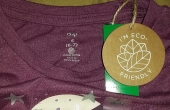
 3
3





"Not many people know that lots of our clothes are made of plastic," says Imogen Napper, a PhD student at Plymouth University, "polyester, acrylic."
Ms Napper and Prof Richard Thompson study marine microplastics - fragments and fibres found in the ocean surface, the deep sea and the marine food chain.
And in a recent lab study, they found that polyester and acrylic clothing shed thousands of plastic fibres each time it was washed- yet another source of plastic pollution in the ocean.
"My friends always make fun of me because they think of marine biology as such a sexy science - all turtles, hot countries and bikinis," says Ms Napper.
"But I've been spending hours washing clothes and counting the fibres."
It might not be exotic, but this painstaking laundry-science has revealed that an average UK washing load - 6kg (13lb) of fabric - can release:
140,000 fibres from polyester-cotton blend
nearly half a million fibres from polyester
more than 700,000 fibres from acrylic







 1
1

















 2
2










"Study books and observe nature; if they do not agree, throw away the books." ~ William A. Albrecht
 7
7




Visit Redhawk's soil series: https://permies.com/wiki/redhawk-soil
How permies.com works: https://permies.com/wiki/34193/permies-works-links-threads
 1
1




 1
1














 6
6




Visit Redhawk's soil series: https://permies.com/wiki/redhawk-soil
How permies.com works: https://permies.com/wiki/34193/permies-works-links-threads


















Visit Redhawk's soil series: https://permies.com/wiki/redhawk-soil
How permies.com works: https://permies.com/wiki/34193/permies-works-links-threads














 3
3




Visit Redhawk's soil series: https://permies.com/wiki/redhawk-soil
How permies.com works: https://permies.com/wiki/34193/permies-works-links-threads


















Visit Redhawk's soil series: https://permies.com/wiki/redhawk-soil
How permies.com works: https://permies.com/wiki/34193/permies-works-links-threads














 2
2




The fashion industry produces 10% of all humanity's carbon emissions, is the second-largest consumer of the world's water supply, and pollutes the oceans with microplastics.
85% of all textiles go to the dump each year. And washing some types of clothes sends thousands of bits of plastic into the ocean.
While people bought 60% more garments in 2014 than in 2000, they only kept the clothes for half as long.
The equivalent of one garbage truck full of clothes is burned or dumped in a landfill every second.
Washing clothes, meanwhile, releases 500,000 tons of microfibers into the ocean each year — the equivalent of 50 billion plastic bottles.
Many of those fibers are polyester, a plastic found in an estimated 60% of garments. Producing polyester releases two to three times more carbon emissions than cotton, and polyester does not break down in the ocean.
35% of all microplastics — very small pieces of plastic that never biodegrade — in the ocean came from the laundering of synthetic textiles like polyester.




Visit Redhawk's soil series: https://permies.com/wiki/redhawk-soil
How permies.com works: https://permies.com/wiki/34193/permies-works-links-threads
 1
1




 2
2




Microplastics—particles smaller than 5 millimeters—come from a number of sources. Plastic bags and bottles released into the environment break down into smaller and smaller bits. Your washing machine is another major source: When you launder synthetic clothing, tiny microfibers slough off and get flushed to a wastewater treatment plant. That facility filters out some of the microfibers, trapping them in “sludge,” the treated human waste that’s then applied to agricultural fields as fertilizer. That loads the soil with microplastic. A wastewater plant will then flush the remaining microfibers out to sea in the treated water. This has been happening for decades, and because plastics disintegrate but don’t ever really disappear, the amount in the ocean has been skyrocketing.“

|
He was expelled for perverse baking experiments. This tiny ad is a model student:
The new kickstarter is now live!
https://www.kickstarter.com/projects/paulwheaton/garden-cards
|







